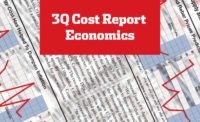Economics
3Q 2024 Cost Report: Rate Cuts Expected to Spur Construction Activity in 2025

Related Link:
ENR 2024 3Q Cost Report PDF
(Subscription Required)
Following months of speculation, the Federal Reserve cut interest rates in September by half a percentage point, and a boost in new construction is expected as soon as the start of next year, economists say.
“With their attention now turning to avert further cooling of the labor market, Federal Reserve policymakers received new evidence that inflation is still declining, paving the way for the first interest rate cut in Q3 2024,” says Paul Brussow, president of Rider Levett Bucknall. “New construction will become more in demand as the Fed loosens its monetary policy.”
Dodge Construction Network reports that the dollar value of construction starts is up 4% over the first eight months of the year, compared to the same time period in 2023. “Now that the Federal Reserve has begun to lower rates the construction sector should begin to feel relief,” says Richard Branch, chief economist at Dodge.“It will take successive rate cuts before [owners and developers] feel comfortable moving these projects forward to start. Starts should show stronger and more consistent growth in the first quarter of 2025.”
Single-family Starts Rising
Residential starts rose 8%, in dollar value through August of this year, according to Dodge. The increase is due to a significant boost in single-family housing, at a rate of 19% year-to-date. Multifamily starts have dropped 10% in the same time period, which Branch attributes to higher availability and vacancy rates among existing units. The largest multifamily housing projects to begin construction in the past two months were the $332-million renovation of the West Brighton I and II apartments in Staten Island, N.Y., and the $300-million Music Row Albion apartment tower in Nashville.
Non-residential starts are 3% higher through August, compared to 2023. Institutional starts, particularly in education and health care, are the “main driver,” says Branch, rising 13%. Commercial starts are flat overall; data centers and hotel starts have increased, while warehouse and traditional office starts are on the decline. In this sector, the largest projects to start work in July and August were the $2.6-billion modernization and expansion of Terminal 3 at San Francisco International Airport and the $2.1-billion Novo Nordisk expansion in Clayton, N.C.
In the non-building sector, “starts appear to be stumbling,” down 1% on a year-to-date basis through August, says Branch. “However, the decline is centered around a slowdown in utility/gas starts [-17%] while public works projects are posting modest growth [at 5%].” The $1.5-billion Revolution Offshore Wind project off the coast of Narragansett, R.I., and the $819-million Potomac River Tunnel in Washington, D.C., are the largest non-building projects to break ground in the last two months.
Wages Remain High
“The start of the monetary policy easing cycle in the U.S. will eventually bring strength back to residential construction, and consequently lumber demand.”
—Luke Lillehaugen, Senior Economist, S&P Global Market Intelligence
While the rate cut by the Federal Reserve will help ease some construction costs, labor shortages continue to plague the industry. “The underlying lack of skilled labor is probably going to continue in the future,” says Brussow. “Rising salaries in the construction industry are a result of the persistent lack of skilled labor, which raises the overall cost of projects.”
Michael Guckes, chief economist at ConstructConnect, shares a similar sentiment regarding high labor costs. “Overall construction labor prices are rising … 4.4% over [year-over-year]. In some segments, such as remodeling, we see hourly wages rising by over 7%,” says Guckes. “Construction workers are also averaging 39 hours per week on the job, nearly 5 hours more than the average private-sector worker. Wage and hours worked trends suggest that labor is and will remain the dominant driver of construction costs, at least over the near term.”
Up and Down
“New construction will become more in demand as the Fed loosens its monetary policy.”
—Paul Brussow, President, Rider Levett Bucknall
Lumber prices have seen a lot of movement so far this year, both decreasing and increasing in price, according to S&P Global Market Intelligence. “Softwood lumber prices have bounced around a lot through the first three quarters of 2024,” says S&P senior economist Luke Lillehaugen. “This is expected to continue through the end of the year before more typical price patterns return in 2025.”
The S&P Global Intelligence third quarter forecast predicts softwood lumber prices will decline 6% overall this year before rebounding 4.6% in 2025. “The start of the monetary policy easing cycle in the U.S. will eventually bring strength back to residential construction, and consequently lumber demand,” say Lillehaugen. “But this process will take time and no significant pricing impacts are likely to be seen before the middle of 2025.”


.jpg?height=200&t=1671747499&width=200)

